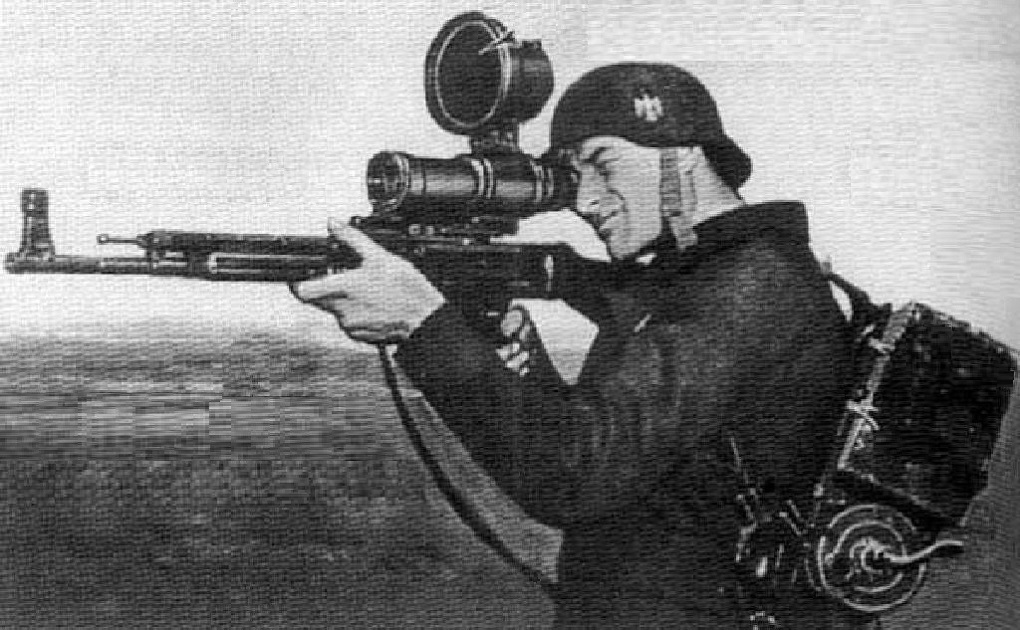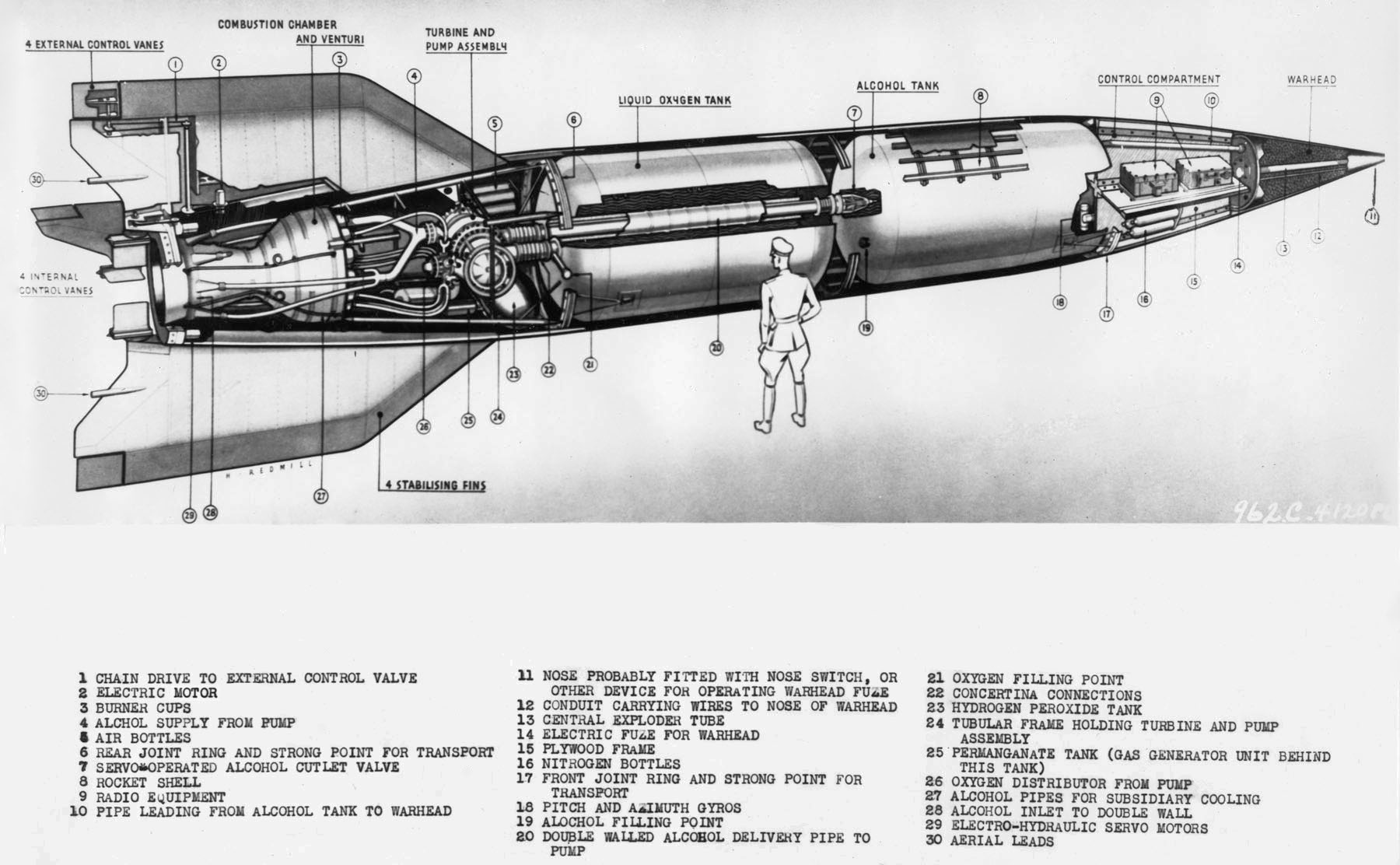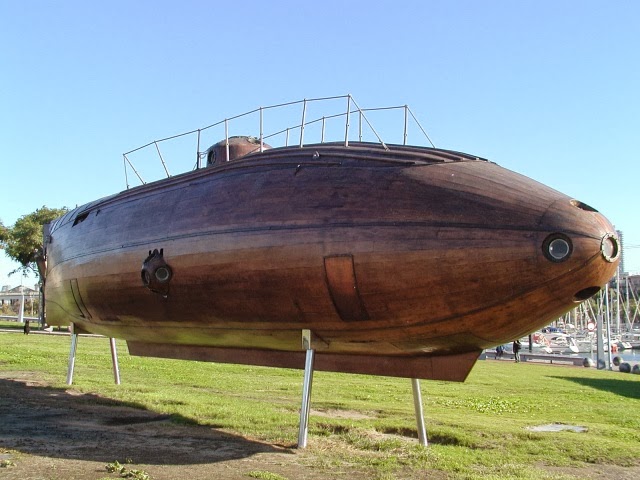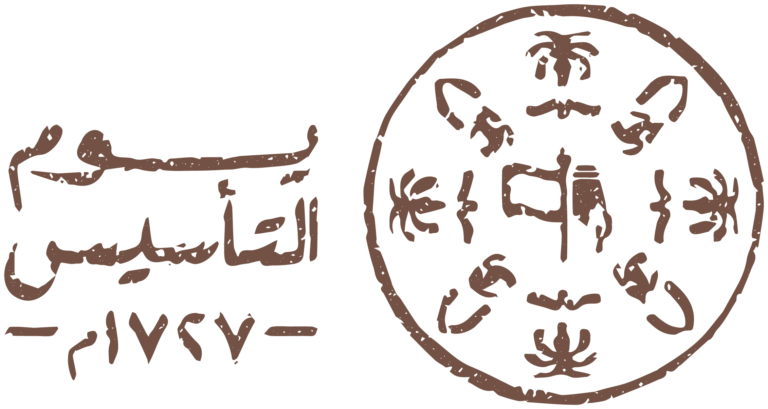الڤي-2 (ألمانية: Vergeltungswaffe 2 وتعني سلاح الإنتقام) وعرف اختصارا باسم V-2 هو أول صاروخ باليستي وأول جهاز من صنع بشري يصل إلى مدار كوكب الأرض. يعد الڤي-2 الأساس الذي بنيت عليه كل الصواريخ الحديثة بما فيها الصاروخ القمري ساتورن 5. أطلق الجيش الألماني خلال الحرب العالمية الثانية أكثر من 3,000 صاروخ ڤي-2 على قوات الحلفاء تسببت في مقتل أكثر من 7,250 شخص ما بين مدني وعسكري
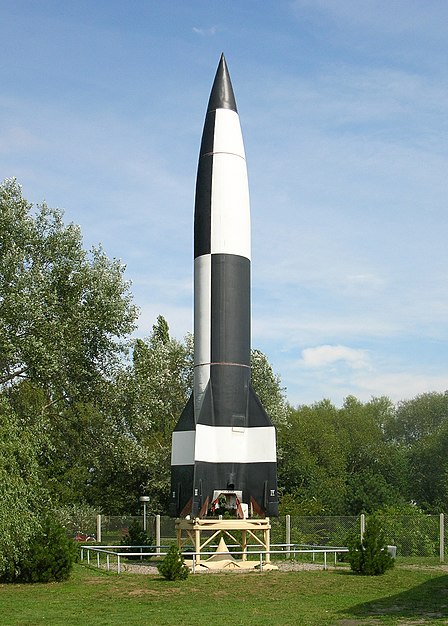
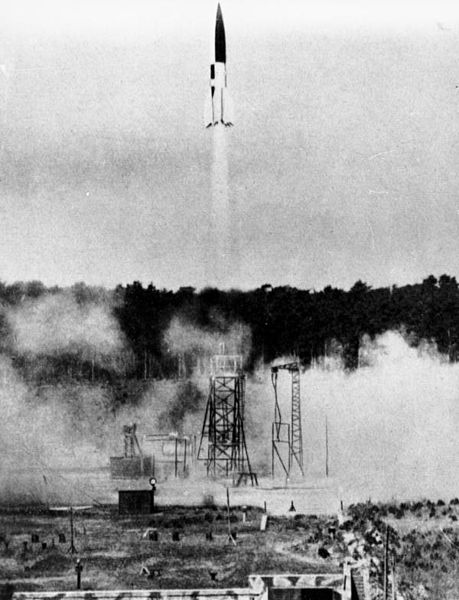
التطوير:
صمم المهندس الألماني فيرنر فون براون جيلين من الصاروخ "أجريجيت"، وبعد نجاحهم، بدأ بالتفكير مع والتر ريدل في تصميم صاروخ أكبر بكثير في صيف عام 1937. أوقف مشروع "أجريجيت 4" الإيه-4 لفترة بعد حدوث عدة مشاكل في ثبات الصاروخ الإيه-3 أثناء الطيران في يوليو 1936. في عام 1937 حدد فون براون الأداء المطلوب من الإيه-4 وتم إعطاء الأمر بتصميم وتصنيع الصاروخ بين عامي 1938/1939.
في أواخر عام 1941 حصل مركز الأبحاث التابع للجيش الألماني على التكنولوجيا الكافية لجعل صاروخ الإيه-4 صاروخا ناجحا. كانت هناك ثلاث عوامل رئيسية أدت لنجاح الصاروخ، المحركات الضخمة المدفوعة بالوقود المسال، وديناميكا الهواء الفوق صوتية، والتحكم وتوجيه الصاروخ. في ذلك الوقت لم يكن هتلر منبهرا بصاروخ الڤي-2 حيث ظن أنه كان مجرد قذيفة مدفعية بعيدة المدى في مقابل سعر أعلى بكثير.
في أوائل سبتمبر 1943، وعد فون براون لجنة القصف بعيد المدى أن تطوير صاروخ الإيه-4 انتهى عمليا ولكن حتى منتصف عام 1944 لم يكن الإيه-4 جاهزا. كان هتلر منبهرا بمدى حماسة مطوري الصاروخ ولحاجته لسلاح "اعجوبة" ليحافظ على الروح المعنوية للألمان، وافق هتلر على تعبئته بأعداد كبيرة.
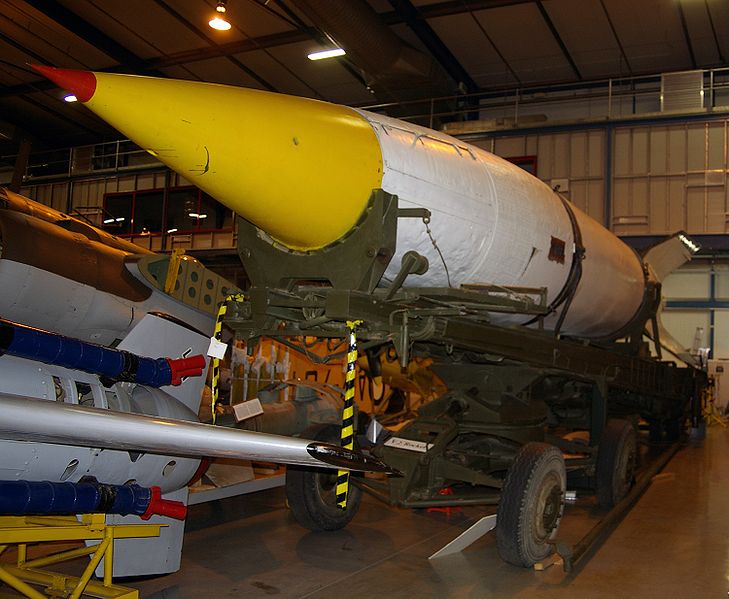

Nazi V-2/A4 Roketi: Technic detail


The V-2 had an operational range of about 300 kilometers (200 miles) carrying a 1000 kg (2000 lb) warhead.
The V-2 was propelled by a mixture of alcohol (ethanol) and water, combined with liquid oxygen. The turbo fuel pumps were propelled by hydrogen peroxide. The water-alcohol mixture was kept in a tank of aluminium to save weight, which put a high pressure on German war economy, as this metal was rare and valuable.
The fuel was pumped through the walls of the main burner, so that it would heat the mixture and at the same time cool the burner, so that it wouldn't melt from the heat. The fuel was then pumped into a main burner chamber through several nozzles, which assured the correct mixture of alcohol and oxygen at all times.
Some later V-2s used "guide beams", i.e. radio signals transmitted from the ground, to navigate the missile toward its target, but the first models used a simple analog computer that would adjust the azimuth for the rocket, and the flying distance was controlled by the amount of fuel, so that when the fuel ran out "brennschluss", the rocket would stop accelerating and soon reach the top of the parabolic flight curve.
The painting of the operational V-2s was mostly a camouflage ragged pattern with several variations, but in the end of the war a plain olive green rocket also appeared. During tests, the rocket was painted in a characteristic black/white chessboard pattern which aided in determining if the rocket was spinning around its own longitudinal axis.

The ballistic trajectory of the V2-rocket
The V2 was a ballistic rocket. The rocket ascended vertically over 4 seconds, after which it followed the programmed trajectory. The rocket ascended over a period of 43 seconds at an angle of 47°. After approximately 65 seconds the fuel supply was cut off to stop the rocket motor. The projectile described a parabolic trajectory and reached a maximum altitude of approximately 97 kilometres. After reaching the highest point of the trajectory (the so-called culmination point), the rocket started a free fall on the target. At this point a small number of the rockets exploded due to passing through the atmosphere at a wrong angle (Luftzerleger).
The range of the rocket could be influenced only in the first stage of the trajectory, namely at the moment the fuel supply was cut off. The minimum duration of combustion was 45 seconds, which resulted in a firing range of 80 kilometres. The maximum duration of combustion (about 70 seconds) could be attained without cutting off the fuel supply, when the rocket used all the fuel. The rocket could reach 295 kilometres with a variation of 35 kilometres either way. This is why an effective attainment of 260 kilometres was used.



Turbine pumps and steam generator
The alcohol and liquid oxygen were pumped into the combustion chamber by means of two fuel pumps mounted on a common axis. These powerful pumps were driven by a steam turbine with a power of 675 H.P. At full power the pumps had an output of 5000 revolutions per minute. Only this way could the 8.75 tons of fuel be delivered in 6 to 7 minutes. The pumping unit weighed 450 kilogram. The steam for the turbine was produced in a generator. Hydro peroxide and calcium permanganate were mixed in the generator. The resulting chemical reaction generated overheated steam, which drove the turbines.
The turbine pump and the steam generator were the most vulnerable parts of the V2: only one factory at Jenbach in Austria could produce the turbine pumps. This required high precision machines and an eminent production management. The Allies were not aware of this and never employed their strategic bombardments against this factory. The interruption of the supply of turbine pumps would certainly have stopped the production of V2s immediately.
The alcohol and liquid oxygen were vaporised under pressure by the injection nozzles and delivered to the combustion chamber. After combustion, the gases at a temperature of 1700º C expanded in a nozzle, giving a thrust of 27 to 28.000 kilograms, more than enough to propel the rocket. Four rotating graphite vanes in the tail stabilized the rocket during take-off. External aerodynamic vanes could control the direction while the rocket was in flight. Control became necessary, when the gyroscopes would detect differences between intended flight path and actual flight path.

Technical data of the V2
Dimensions:
Length:14.036 m
Length of the nose:2.285 m
Length of the vanes:3.935 m
Section of the fuselage:1.650 m
Section of the vanes:3.555 m
Weights:
Explosive charge [Amatol]:750 kg
Fuselage:1.750 kg
Pumping unit:450 kg
Combustion chamber:550 kg
Auxiliary devices:300 kg
Alcohol and liquid oxygen:8.750 kg
Turbine fuel:300 kg
Total weight:12.980 kg
Propulsion:25.000 kg
Maximum speed:5580 km/hour
Strike speed:2900 km/hour
Maximum trajectory:97 km
Maximum range:305 km
صاروخ نوع V-2 نازي تم الاستيلاء عليه بعد الحرب يعرض للجمهور في ساحة الطرف الاغر في لندن في 15 سبتمبر 1945
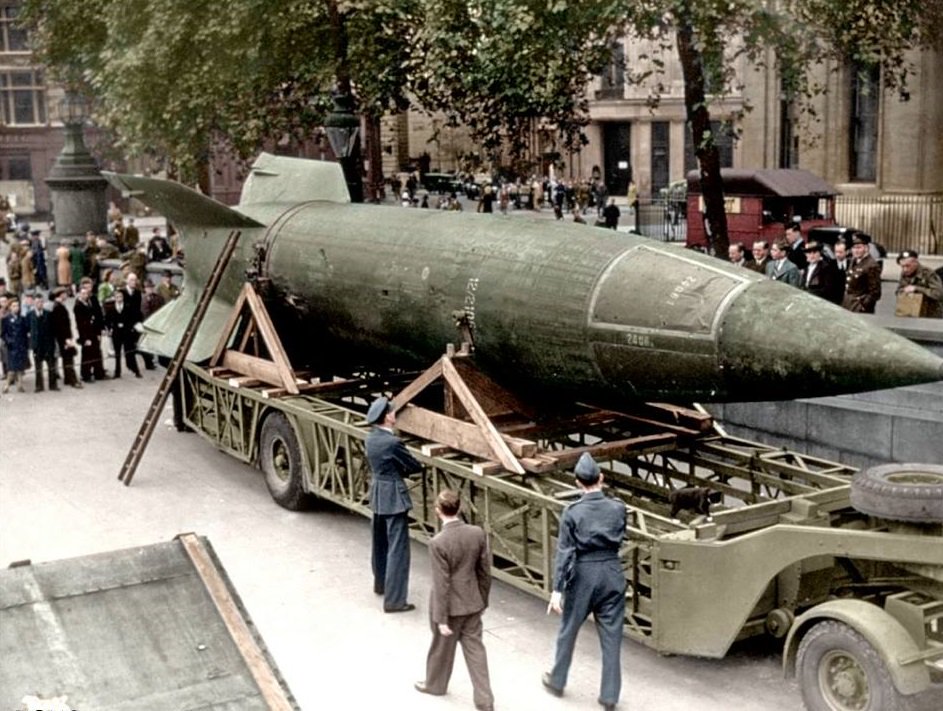


التطوير:
صمم المهندس الألماني فيرنر فون براون جيلين من الصاروخ "أجريجيت"، وبعد نجاحهم، بدأ بالتفكير مع والتر ريدل في تصميم صاروخ أكبر بكثير في صيف عام 1937. أوقف مشروع "أجريجيت 4" الإيه-4 لفترة بعد حدوث عدة مشاكل في ثبات الصاروخ الإيه-3 أثناء الطيران في يوليو 1936. في عام 1937 حدد فون براون الأداء المطلوب من الإيه-4 وتم إعطاء الأمر بتصميم وتصنيع الصاروخ بين عامي 1938/1939.
في أواخر عام 1941 حصل مركز الأبحاث التابع للجيش الألماني على التكنولوجيا الكافية لجعل صاروخ الإيه-4 صاروخا ناجحا. كانت هناك ثلاث عوامل رئيسية أدت لنجاح الصاروخ، المحركات الضخمة المدفوعة بالوقود المسال، وديناميكا الهواء الفوق صوتية، والتحكم وتوجيه الصاروخ. في ذلك الوقت لم يكن هتلر منبهرا بصاروخ الڤي-2 حيث ظن أنه كان مجرد قذيفة مدفعية بعيدة المدى في مقابل سعر أعلى بكثير.
في أوائل سبتمبر 1943، وعد فون براون لجنة القصف بعيد المدى أن تطوير صاروخ الإيه-4 انتهى عمليا ولكن حتى منتصف عام 1944 لم يكن الإيه-4 جاهزا. كان هتلر منبهرا بمدى حماسة مطوري الصاروخ ولحاجته لسلاح "اعجوبة" ليحافظ على الروح المعنوية للألمان، وافق هتلر على تعبئته بأعداد كبيرة.


Nazi V-2/A4 Roketi: Technic detail

The V-2 had an operational range of about 300 kilometers (200 miles) carrying a 1000 kg (2000 lb) warhead.
The V-2 was propelled by a mixture of alcohol (ethanol) and water, combined with liquid oxygen. The turbo fuel pumps were propelled by hydrogen peroxide. The water-alcohol mixture was kept in a tank of aluminium to save weight, which put a high pressure on German war economy, as this metal was rare and valuable.
The fuel was pumped through the walls of the main burner, so that it would heat the mixture and at the same time cool the burner, so that it wouldn't melt from the heat. The fuel was then pumped into a main burner chamber through several nozzles, which assured the correct mixture of alcohol and oxygen at all times.
Some later V-2s used "guide beams", i.e. radio signals transmitted from the ground, to navigate the missile toward its target, but the first models used a simple analog computer that would adjust the azimuth for the rocket, and the flying distance was controlled by the amount of fuel, so that when the fuel ran out "brennschluss", the rocket would stop accelerating and soon reach the top of the parabolic flight curve.
The painting of the operational V-2s was mostly a camouflage ragged pattern with several variations, but in the end of the war a plain olive green rocket also appeared. During tests, the rocket was painted in a characteristic black/white chessboard pattern which aided in determining if the rocket was spinning around its own longitudinal axis.

The ballistic trajectory of the V2-rocket
The V2 was a ballistic rocket. The rocket ascended vertically over 4 seconds, after which it followed the programmed trajectory. The rocket ascended over a period of 43 seconds at an angle of 47°. After approximately 65 seconds the fuel supply was cut off to stop the rocket motor. The projectile described a parabolic trajectory and reached a maximum altitude of approximately 97 kilometres. After reaching the highest point of the trajectory (the so-called culmination point), the rocket started a free fall on the target. At this point a small number of the rockets exploded due to passing through the atmosphere at a wrong angle (Luftzerleger).
The range of the rocket could be influenced only in the first stage of the trajectory, namely at the moment the fuel supply was cut off. The minimum duration of combustion was 45 seconds, which resulted in a firing range of 80 kilometres. The maximum duration of combustion (about 70 seconds) could be attained without cutting off the fuel supply, when the rocket used all the fuel. The rocket could reach 295 kilometres with a variation of 35 kilometres either way. This is why an effective attainment of 260 kilometres was used.



Turbine pumps and steam generator
The alcohol and liquid oxygen were pumped into the combustion chamber by means of two fuel pumps mounted on a common axis. These powerful pumps were driven by a steam turbine with a power of 675 H.P. At full power the pumps had an output of 5000 revolutions per minute. Only this way could the 8.75 tons of fuel be delivered in 6 to 7 minutes. The pumping unit weighed 450 kilogram. The steam for the turbine was produced in a generator. Hydro peroxide and calcium permanganate were mixed in the generator. The resulting chemical reaction generated overheated steam, which drove the turbines.
The turbine pump and the steam generator were the most vulnerable parts of the V2: only one factory at Jenbach in Austria could produce the turbine pumps. This required high precision machines and an eminent production management. The Allies were not aware of this and never employed their strategic bombardments against this factory. The interruption of the supply of turbine pumps would certainly have stopped the production of V2s immediately.
The alcohol and liquid oxygen were vaporised under pressure by the injection nozzles and delivered to the combustion chamber. After combustion, the gases at a temperature of 1700º C expanded in a nozzle, giving a thrust of 27 to 28.000 kilograms, more than enough to propel the rocket. Four rotating graphite vanes in the tail stabilized the rocket during take-off. External aerodynamic vanes could control the direction while the rocket was in flight. Control became necessary, when the gyroscopes would detect differences between intended flight path and actual flight path.

Technical data of the V2
Dimensions:
Length:14.036 m
Length of the nose:2.285 m
Length of the vanes:3.935 m
Section of the fuselage:1.650 m
Section of the vanes:3.555 m
Weights:
Explosive charge [Amatol]:750 kg
Fuselage:1.750 kg
Pumping unit:450 kg
Combustion chamber:550 kg
Auxiliary devices:300 kg
Alcohol and liquid oxygen:8.750 kg
Turbine fuel:300 kg
Total weight:12.980 kg
Propulsion:25.000 kg
Maximum speed:5580 km/hour
Strike speed:2900 km/hour
Maximum trajectory:97 km
Maximum range:305 km
صاروخ نوع V-2 نازي تم الاستيلاء عليه بعد الحرب يعرض للجمهور في ساحة الطرف الاغر في لندن في 15 سبتمبر 1945



